Algarve-South-Portugal.com
The best independent guide to Tavira
Algarve-South-Portugal.com
The best independent guide to Tavira
Tavira; the best sights, attractions and things to see and do in 2025
Tavira stands out as the most beautiful town on Portugal's eastern coast. With its cobbled streets, historic bridges, and traditional architecture, it offers visitors a glimpse of authentic Portugal away from the busier tourist towns of the central and western Algarve.
This picturesque riverside town combines centuries of history with modern comforts, making it perfect for both day trips and longer holidays. The historic center is packed with significant sights-from ancient castle ruins and Renaissance churches to lively plazas and markets. Just a short boat ride away, you'll find some of the region's most pristine beaches on the barrier islands.
Our guide covers all the essential sights and activities Tavira has to offer. It has been organised into two main sections: first, the must-see attractions within Tavira town itself, ideal for day visitors; second, the best activities and nearby destinations that make this area perfect for a longer stay.
Related articles: Tavira introduction – Tavira beaches
The best of Tavira
Here is a brief summary of the best sights of Tavira, followed by highlights of the surrounding region. All of these attractions are explained in more depth later in the guide.
- Sights in Tavira:
1) Castelo de Tavira - Ancient Moorish castle ruins with battlements offering panoramic views of the town. - 2) Ponte Romana - Seven-arched bridge spanning the Gilão River, forming the picturesque heart of Tavira.
- 3) Praça da República - Charming central plaza lined with cafés and historic buildings.
- 4) Igreja de Santa Maria do Castelo – Built atop an ancient mosque, this landmark church blends Gothic elements with Tavira's history.
- 5) Bairro dos Pescadores - Colourful traditional fishermen's quarter decorated with distinctive Portuguese azulejos tiles.
- 6) Camera Obscura - Unique 360° real-time projection of Tavira housed in a converted water tower.
- 7) Cais das Quatro Águas - Picturesque quay where boats depart for Ilha de Tavira.
- 8) Igreja da Misericórdia - Renaissance church featuring exquisite 18th-century azulejo panels depicting the Works of Mercy.
- 9) Mercado Municipal - Vibrant local market filled with fresh produce, regional specialties, and authentic Algarve atmosphere.
- 10) Palácio da Galeria - Historic palace housing Tavira's municipal art gallery (Museu Municipal) with rotating exhibitions in a beautifully restored setting.
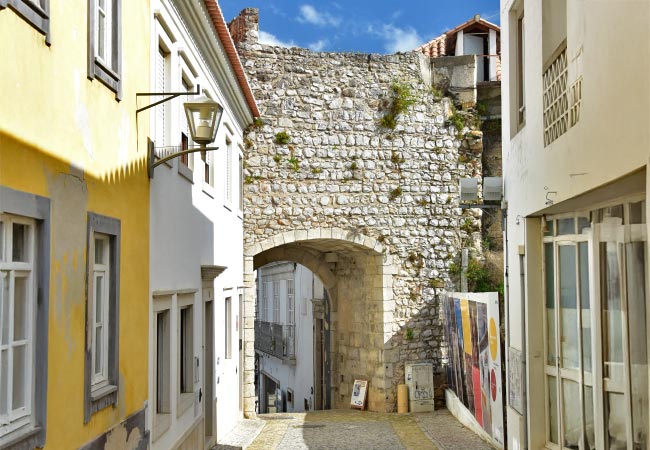
- Best activities and sights for a holiday to Tavira:
- 1) Praia de Tavira - Expansive golden sand beach on Ilha de Tavira, accessible by ferry and offering excellent facilities for a perfect day by the sea.
- 2) Vila Real de Santo António - Elegant border town with distinctive grid layout, riverside promenade, and grand plazas.
- 3) Santa Luzia - Charming fishing village specialising in Octopus fishing, where authentic seafood restaurants line the quiet harbour.
- 4) Ecovia do Litoral to Cacela Velha - Scenic coastal cycling route leading to a picturesque village with spectacular sea views from its clifftop position.
- 5) Tavira Equestrian - Unforgettable horseback riding along empty beaches, catering to all experience levels.
- 6) Parque Natural da Ria Formosa - Protected lagoon system rich in birdlife and marine life, best explored by kayak or boat tour through its winding channels.
- 7) Cemitério das Âncoras - Haunting collection of rusting anchors on Barril beach, commemorating the region's abandoned tuna fishing industry.
- 8) Cabanas - Laid-back waterfront village popular with long-stay residents, offering boat access to unspoiled beaches on the barrier islands.
- 9) Olhão - The Algarve's largest fishing port with distinctive cubist fishing houses and vibrant markets.
- 10) Praia da Terra Estreita - Secluded stretch of sand offering tranquillity away from busier beaches.
For a full guide to the sights and activities of the eastern Algarve please see this guide – East Algarve sights & activities
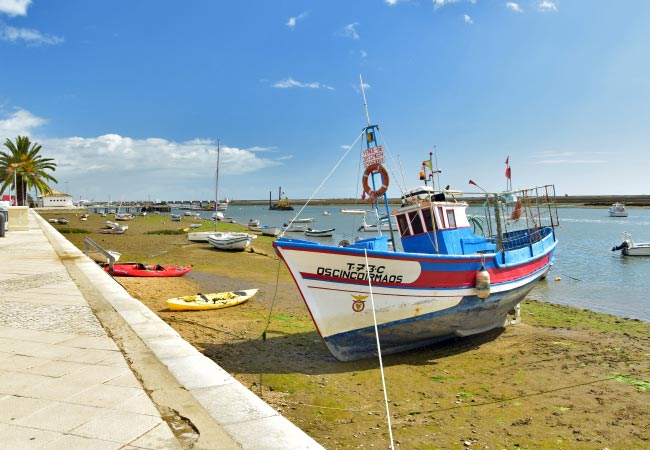
The waterfront of Santa Luzia
The interactive map below displays Tavira's highlights in green markers and the best attractions of the surrounding region in yellow markers. Note: Zoom out to see all of the regional markers.
Sights in Tavira : 1) Castelo de Tavira 2) Ponte da Roman 3) Praça da República 4) Igreja de Santa Maria do Castelo 5) Bairro dos Pescadores 6) Camera Obscura 7) Cais das Quatro Águas 8) Igreja da Misericordia 9) Mercado Municipal 10) Palácio da Galeria
Regional Sights : 1) Praia de Tavira 2) Vila Real de Santo António 3) Santa Luzia 4) Cacela Velha 5) Tavira Equestrian 6) Parque Natural da Ria Formosa 7) Cemitério das Âncoras 8) Cabanas 9) Olhão 10) Praia da Terra Estreita
The sights of Tavira
Tavira is a compact town that's a joy to explore for a day trip. The Gilão River divides the town in two: the western bank features the original Moorish settlement, while the eastern side, developed from the 15th century onwards, displays more classical Portuguese architecture.
Castelo de Tavira
The Castelo de Tavira began as an 8th-century Moorish fortification, serving as a key defensive structure during Islamic rule over the Algarve. In 1242, the Christian forces of Dom Paio Peres Correia captured the castle, marking a pivotal moment in Portugal's Reconquista campaign.
Archaeological evidence reveals that the site held military significance since Roman times, with excavations uncovering artifacts spanning multiple centuries of occupation. The castle's original Moorish design featured a classic alcáçova (citadel) layout with an inner courtyard and fortified walls.
Following the Christian conquest, the Order of Santiago added distinctive elements including a keep tower and expanded defensive structures. The devastating 1755 earthquake destroyed much of the original fortress, leaving only sections of walls and foundations that visitors see today.
The castle grounds contain remnants of water cisterns, garrison quarters, and storage facilities that sustained the medieval military outpost. Though modest compared to other Portuguese fortifications, the Castelo de Tavira provides an insight into the region's complex military history and cultural transformation from Islamic settlement to Christian town.
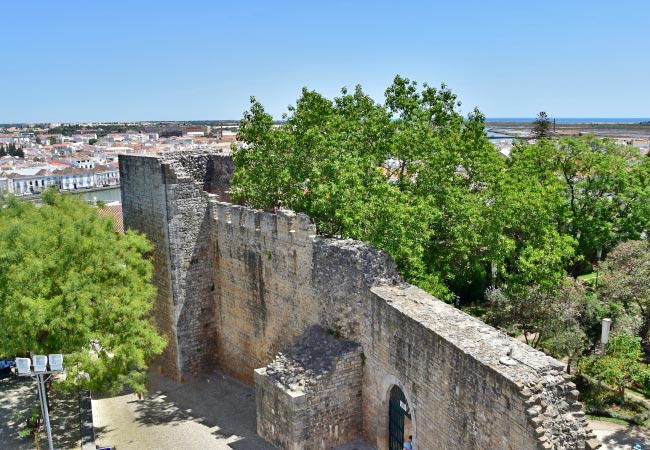
The battlements where designed to withstand cannon fire and extend around the central keep of the castle
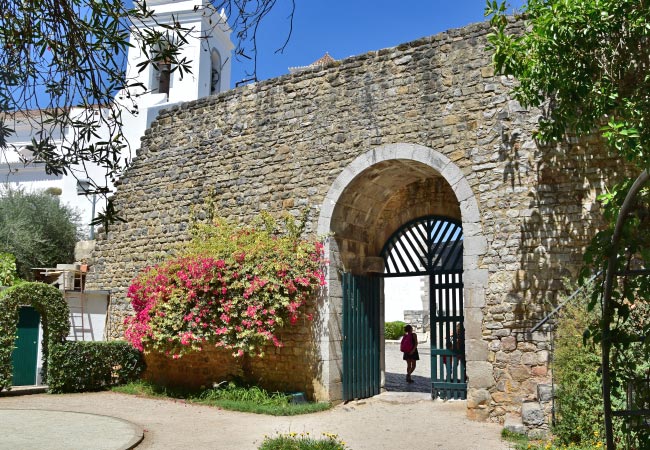
Entry to the castle is through the medieval Arco da Misericórdia gateway
Igreja de Santa Maria do Castelo
Originally built in the 13th century on the foundations of Tavira's main mosque, this historic church stands beside the castle on one of the town's highest points. Following severe damage in the 1755 earthquake, Italian architect Francisco Fabri supervised its reconstruction.
The church holds significant historical importance for commemorating the Christian reconquest of Tavira. Inside lie the tombs of Dom Paio Peres Correia, Master of the Order of Santiago, and the seven knights who died during the campaign against Moorish rulers in 1242.
The exterior features stone-carved Stations of the Cross and an impressive Gothic portico on the main façade. Inside, visitors can view a 13th-century baptismal font and a unique glass-sided ossuary displaying human remains uncovered during archaeological excavations.
The bell tower provides sweeping views across Tavira, showcasing the town's distinctive pyramidal "tesouro" roofs and surrounding landscape.
Entrance fee: €4 (includes tower access)
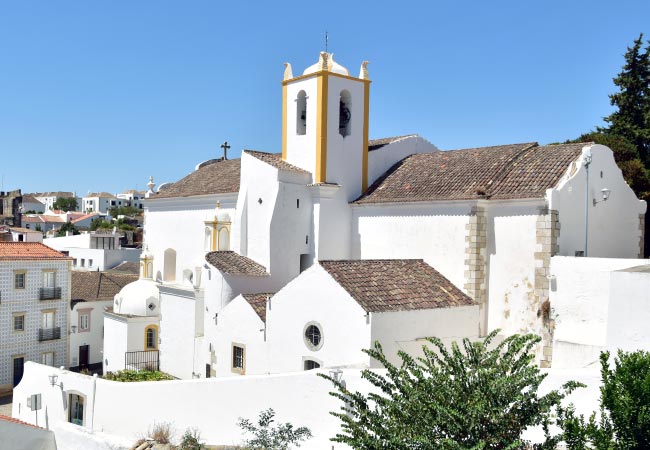
Camera Obscura - Tavira
Housed in the repurposed Torre de Tavira water tower, Tavira's Camera Obscura offers a unique 360° real-time view of the town using ancient optical technology. The device, installed in 2004, employs a system of mirrors and lenses to project a living image of Tavira onto a concave disc in a darkened chamber.
During the 20-minute guided demonstrations, visitors watch the town's activities unfold in real-time while guides highlight architectural features and share historical context. The tower itself stands 30 meters tall, built in 1931, and was repurposed after no longer being needed for water storage. www.cameraobscuratavira.com/
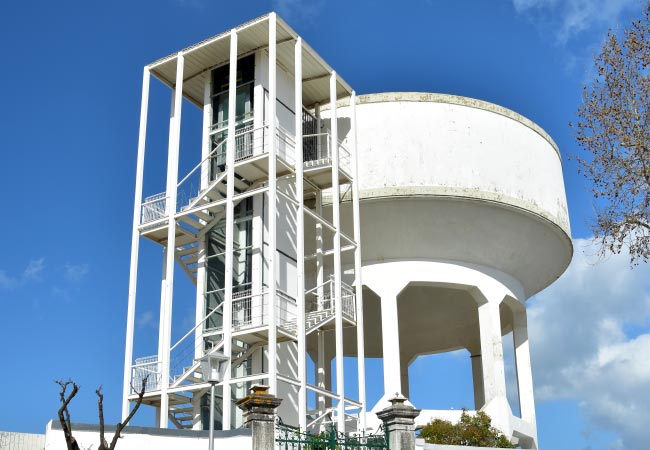
The Praça da República
The Praça da República serves as Tavira's central town square, evolving from a medieval marketplace into the formal civic space seen today, with the River Gilão and the old bridge providing a picturesque backdrop.
This elegant plaza is paved with traditional Portuguese calçada (black and white stone mosaic) and framed by well-preserved historic buildings.At its heart stands Tavira's distinctive old town hall (Paços do Concelho) with its 16th-century arched gallery.
A monument honouring Portuguese heroes of the 4th Infantry Regiment who died during World War I in Flanders stands at the center of the square.
The Tourist Information Office and Islamic Museum occupy the opposite side of the plaza. The museum exhibits a significant section of the original Islamic wall that once protected the citadel, alongside important artifacts including the famous "Tavira Vase." This remarkable 11th-century ceremonial vessel, made from red clay, features 14 figurines (including mounted knights, musicians, and animals).
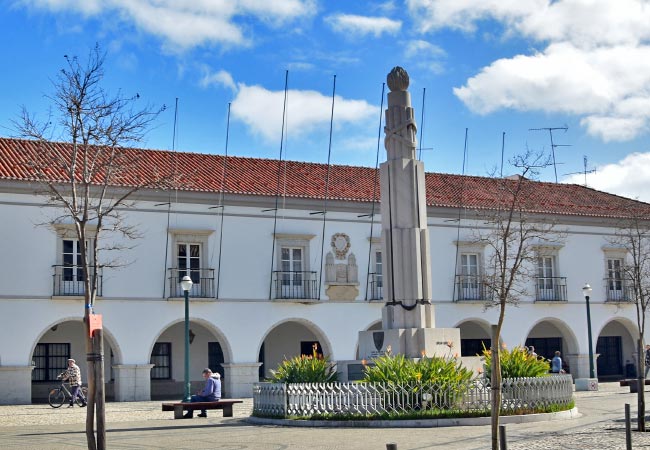
Câmara Municipal de Tavira (Tavira town hall) and the Monumento aos Combatentes da Grande Guerra em Tavira (war memorial)
Mercado Municipal de Tavira
The Mercado Municipal de Tavira is the main market, located on the western side of town near the Gilão River. This covered market serves as a vibrant hub for local commerce and authentic Algarve produce.
Inside, vendors sell fresh seafood caught daily by local fishermen, alongside stalls offering seasonal fruits and vegetables from surrounding farms, regional cheeses, cured meats and honey.
Beyond food, the market sells handcrafted items including Algarve pottery, woven baskets and cork products. It operates primarily in morning hours, with the liveliest atmosphere occurring early when restaurants and locals shop for the freshest selections.
The building itself combines functionality with a simple architectural style typical of mid-20th century Portuguese municipal markets.
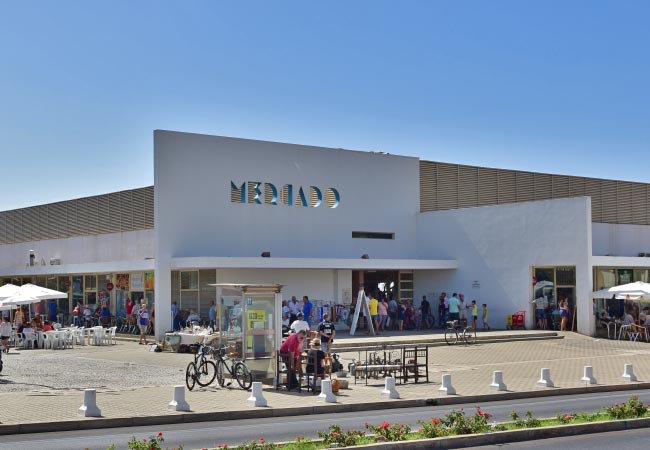
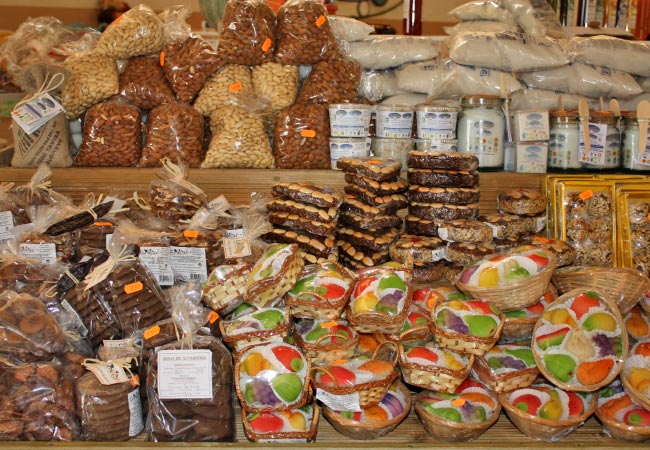
Igreja da Misericórdia
The Igreja da Misericórdia (Church of Mercy) stands as one of Tavira's most significant religious monuments. Originally constructed in 1551 in Renaissance style, the church belongs to the Santa Casa da Misericórdia, a charitable brotherhood established throughout Portugal during the 16th century.
Its façade features an impressive Renaissance portal with Corinthian columns and an image of Nossa Senhora da Misericórdia (Our Lady of Mercy). The church underwent significant restoration after the devastating 1755 earthquake that affected much of the Algarve.
Inside, visitors can admire some of Tavira's finest azulejo tilework. The church walls are adorned with striking 18th-century blue and white tiles depicting scenes from the life of Christ and the works of mercy. These panels, dating from approximately 1760-1775, represent the high artistic achievement of Portuguese tile production.
The interior also contains a notable carved altarpiece in the Baroque style and an ornate gilded wooden ceiling. The sacristy houses valuable religious artifacts and paintings related to the Misericórdia brotherhood's charitable history.
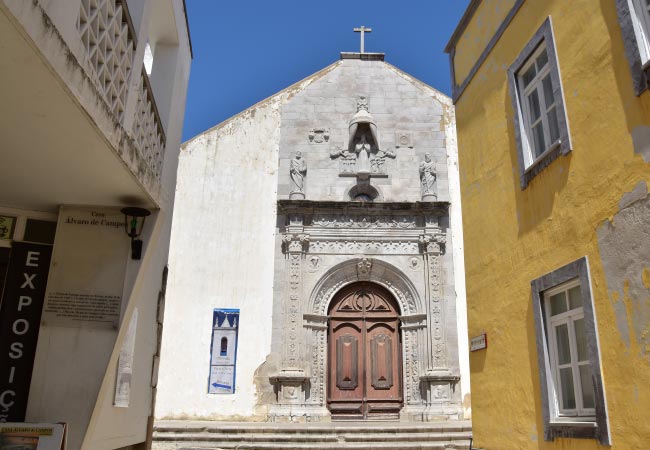
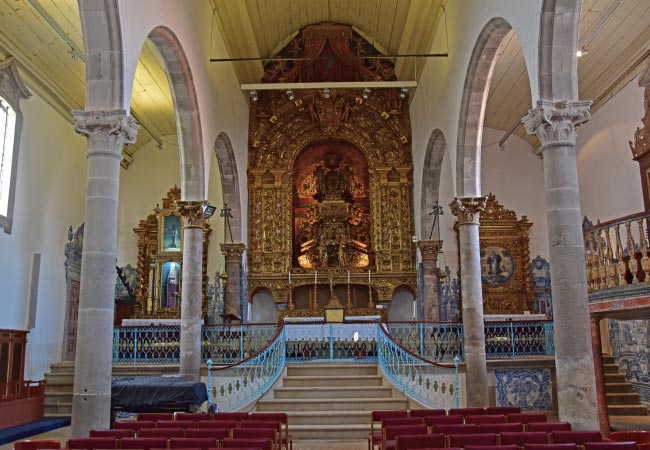
The Ponte Romana Bridge
The Ponte Romana (Roman Bridge) spans the Gilão River in the heart of Tavira, connecting the two sides of the town. Despite its common name, the current structure isn't actually Roman in origin. The existing seven-arched bridge dates primarily from the 17th century, though it was built upon earlier medieval foundations.
Historical records suggest that while a crossing likely existed during Roman times (when Tavira was known as Balsa), the current bridge has undergone multiple reconstructions over the centuries, particularly after flood damage. The most significant rebuilding occurred following the devastating 1755 earthquake that affected much of the region.
The bridge features a characteristic hump-backed design with elegantly cut stone arches and traditional cobblestone paving.
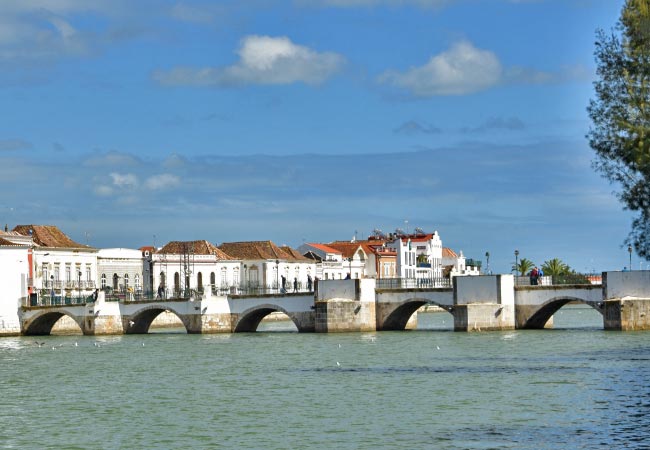
Bairro dos Pescadores
The Bairro dos Pescadores is the traditional fishermen's quarter of Tavira. The modest homes of the neighbourhood are traditionally adorned with decorative ceramic tiles (azulejos).
These tiles, typically in blue, yellow, and green patterns, protect the houses from the harsh coastal elements while reflecting heat during summer months.
Many houses display geometric patterns, while others feature floral motifs or maritime themes reflecting the occupants' connection to the sea. Some homes include decorative borders that frame windows and doors, adding architectural detail to otherwise simple structures.
This tiling tradition dates back to the influence of Moorish design principles that remained in Portugal's southern regions long after the Reconquista. The tradition continued through the centuries as both a practical building technique and as a distinctive form of artistic expression
Cais das Quatro Águas
The Cais das Quatro Águas is a quay located about 3 kilometres from Tavira's center, where the Gilão River meets the Atlantic Ocean. This small harbour serves as the main departure point for boats heading to Ilha de Tavira (Tavira Island) and its popular beaches.
Originally developed as a fishing port, the quay remains active with local fishermen using it as their base. The name "Quatro Águas" (Four Waters) refers to the confluence of several waterways in this estuarine environment.
The area features several seafood restaurants specializing in fresh local catch, particularly octopus and shellfish from the Ria Formosa lagoon system.
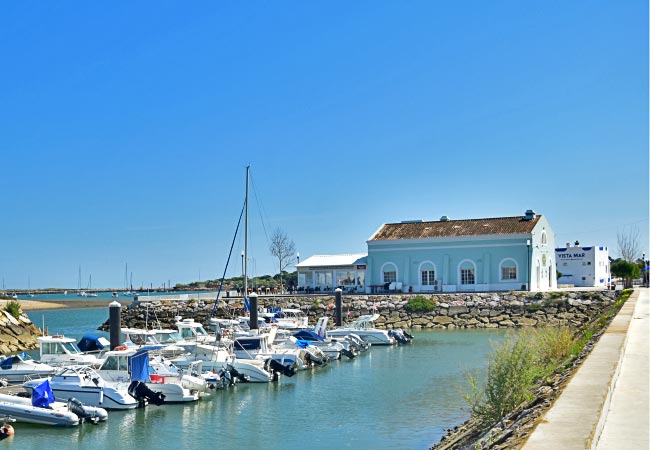
Palácio da Galeria and Museu Municipal de Tavira
The Palácio da Galeria is a former 16th-century Renaissance palace that today houses the Museu Municipal de Tavira.
Originally a nobleman's residence, the palace features Manueline and Renaissance elements, including an elegant courtyard and ornate stone detailing. Though damaged in the 1755 earthquake, it was later restored and acquired by the municipality in the late 20th century to serve as Tavira's main museum.
Today, the Museu Municipal showcases archaeological findings from the region, with exhibits spanning from prehistoric periods through Roman occupation, Islamic rule, and later Christian eras. The collection includes ceramics, architectural fragments, and everyday objects that illustrate Tavira's rich multicultural history.
Mercado da Ribeira
The Mercado da Ribeira is a historic marketplace building located near the Gilão River. Constructed in the late 19th century, it once served as Tavira's main food market where local fishermen and farmers sold fresh produce.
The building features distinctive architectural elements including wrought iron details and large arched doorways typical of Portuguese public markets from this era. Its riverside location allowed fishermen to bring their catch directly to market.
In the 1990s, after market activities relocated to the newer Mercado Municipal, the Mercado da Ribeira was repurposed. Today, it houses small craft shops, cafés, and artist studios, transforming this historic space from a traditional food market into a cultural and commercial center.
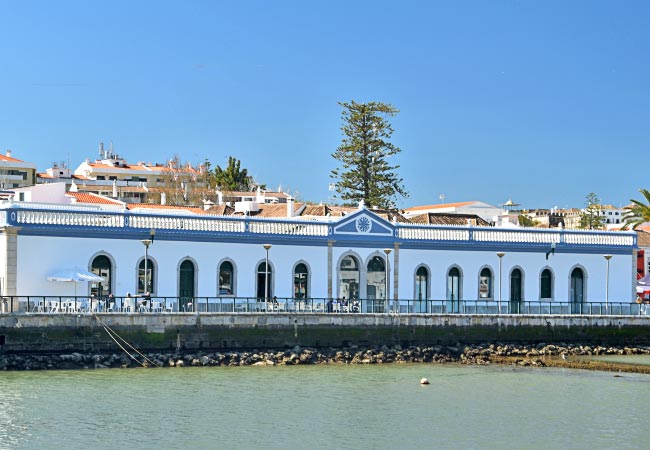
Porta de D. Manuel I
The Porta de D. Manuel I is one of the few surviving elements of Tavira's medieval defensive walls. This historic gateway dates from the early 16th century during the reign of King Manuel I (1495-1521), after whom it is named.
The gate displays architectural elements of the Manueline style - Portugal's distinctive late Gothic approach characterized by maritime motifs and elaborate stonework.
As one of the main entry points to the walled city, this gate controlled access while collecting taxes on goods entering Tavira. While most of Tavira's defensive walls were dismantled in later centuries to allow urban expansion, the Porta de D. Manuel I was preserved due to its historical significance.
Igreja de São Paulo
The Igreja de São Paulo (Church of St. Paul) stands as one of Tavira's most architecturally distinctive religious buildings. Constructed in the 16th century, it departs from traditional church design with its unusual octagonal floor plan - a rare feature in Portuguese religious architecture.
Initially built during the Renaissance period, the church underwent significant modifications in the 17th and 18th centuries, introducing Baroque and Rococo elements to its interior. The building features a central dome supported by the octagonal structure, creating a unified interior space.
Inside, visitors can observe ornate gilded woodwork on the altars, typical of Portuguese Baroque style, along with decorative tile panels that complement the architectural elements.
The church was originally associated with the Jesuits before their expulsion from Portugal in 1759, after which it continued to serve the local community.
Antigo Convento da Graça
The vivid yellow Antigo Convento da Graça is one of Tavira's most striking and significant Renaissance-styled buildings. It was originally established in 1569 as an Augustinian monastery and functioned as such until the dissolution of religious orders in Portugal in 1834.
The convent features a notable cloister with elegant arched galleries supported by classical columns - a hallmark of Renaissance architecture in Portugal. The building also includes a former church with a simple yet dignified façade characteristic of the austere style favoured by certain religious orders of the period.
Following the 1834 religious reforms, the building served various public functions, including military and educational uses, before falling into disrepair during the 20th century. In the 1990s, it underwent extensive restoration as part of Portugal's Pousadas program, which converts historic buildings into luxury heritage hotels.
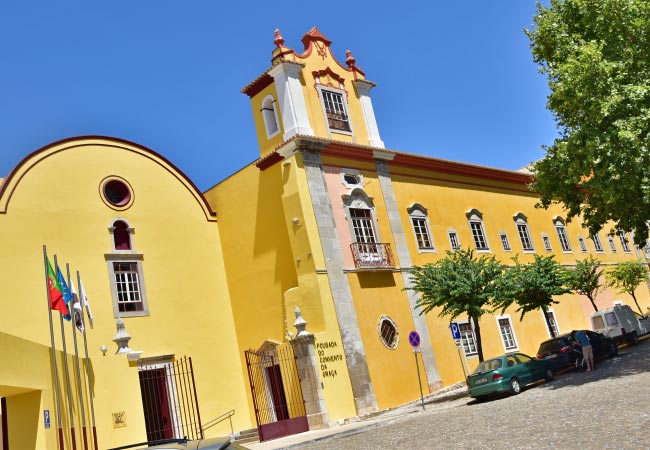
Jardim do Coreto
The Jardim do Coreto (Bandstand Garden) is a picturesque public space located along the banks of the Gilão River. Created in the late 19th century during a period of urban modernization, the garden exemplifies the European trend of developing civic spaces for public leisure and cultural activities.
At the heart of the garden stands a traditional iron bandstand (coreto), where the town band would perform concerts for the community. This ornate structure, with its decorative metalwork and elevated platform, reflects the architectural aesthetics of the Belle Époque period.
The garden features carefully maintained flowerbeds, mature trees providing welcome shade during hot Algarve summers, and paved walkways throughout the grounds.
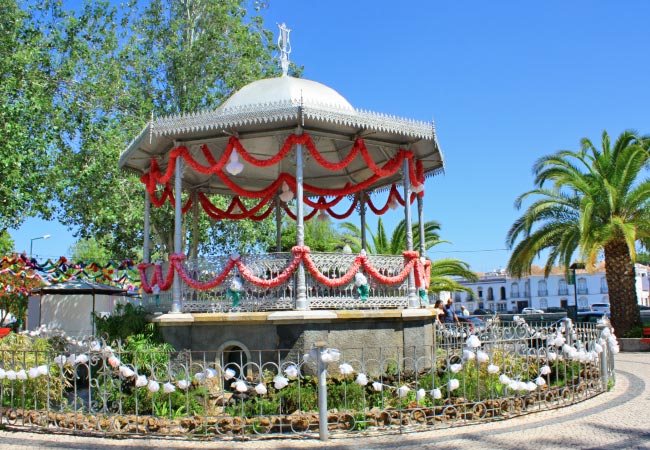
Things to do - for a holiday to Tavira
Relax on Tavira’s beautiful beaches
Tavira is blessed with some of the Algarve's most stunning coastline, featuring pristine golden sands and crystal-clear turquoise waters. The beaches stretch along Ilha de Tavira, a barrier island that extends for over 10km, protecting the mainland and creating perfect swimming conditions.
Praia de Tavira is easily accessible via a short ferry ride from Cais das Quatro Águas or from Tavira's town center during the summer months. The beach lies on the seaward side of the barrier island and is just a short walk from the ferry terminal.
The Praia de Tavira is well-equipped with excellent facilities including restaurants, sunbed rentals, and water sports equipment, making it ideal for families and visitors seeking both relaxation and recreation. Despite its popularity, it rarely feels overcrowded even in peak season. The waters remain pleasantly warm from May through October, with gentle waves perfect for swimmers of all abilities.
Related articles: Tavira beach guide
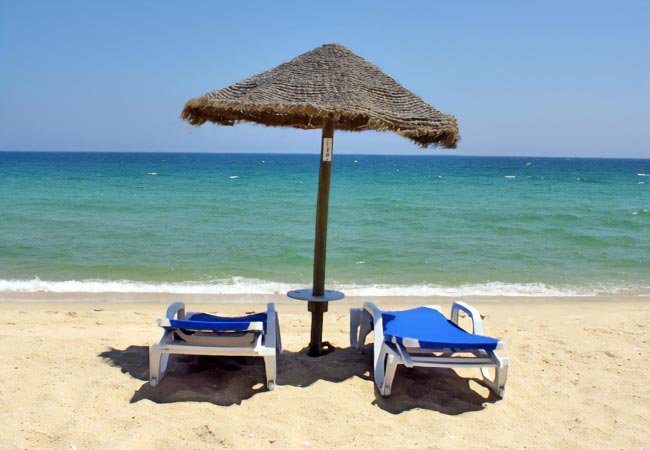
The Praia de Tavira offers soft sands and turquoise sea waters
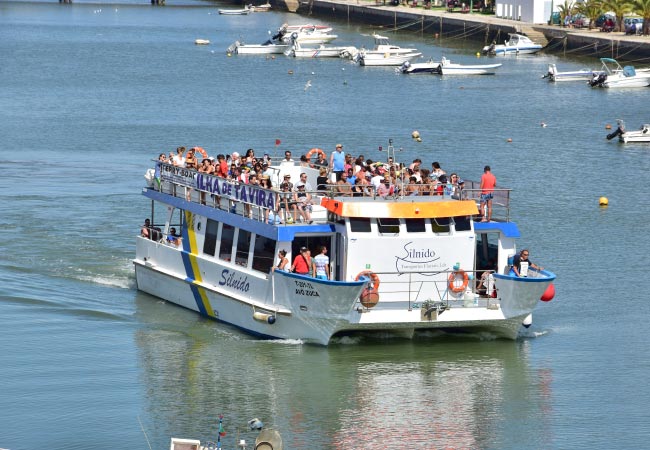
The ferry heading to the Ilha de Tavira
The Parque Natural da Ria Formosa
The Parque Natural da Ria Formosa encompasses the salt lagoons and tidal mudflats that stretch between the Ilha de Tavira and the mainland.
This protected wetland system spans 60km along the Algarve coast and represents one of Portugal's most important ecological treasures. These pristine wetlands support remarkably diverse wildlife, serving as a crucial habitat for migratory birds and many wading species. Visitors can spot flamingos, spoonbills, and the rare purple swamphen among many other birds.
The park also protects fragile marine ecosystems. It is home to one of Europe's largest concentrations of seahorses. The area also preserves traditional fishing techniques and supports small fishing communities that have worked these waters for generations.
The intricate network of tranquil waterways can be explored in several ways. Hiring a kayak or stand-up paddleboard offers a fun and peaceful way to navigate the calm, shallow waters at your own pace.
Alternatively, knowledgeable guides offer informative boat tours departing regularly from Tavira harbour. These tours provide fascinating insights into the park's ecology, history, and conservation efforts.
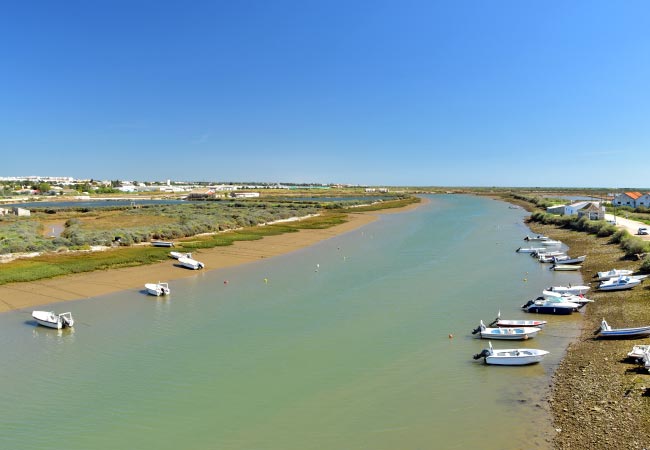
The Gilão River as it passes through the Ria Formosa
Dining on Fine and Traditional Cuisines
Tavira has a mature and social nightlife scene, which is focused around the evening meal. During the evening, the smell of freshly cooked fish fills the historic centre, as tourists and locals alike dine al-fresco, enjoying dishes prepared with the day's catch.
The Algarve region is known for its distinctive seafood specialties. One of the most popular dishes is Cataplana, a hearty seafood stew typically containing clams, prawns, chorizo, and vegetables. It's traditionally served in a large copper pot of the same name and is designed to be shared between two people.
Other local specialties include Arroz de Marisco (seafood rice), fresh grilled sardines, and Polvo à Lagareiro (octopus roasted with olive oil and garlic). These dishes are often accompanied by regional wines, particularly the crisp white wines from nearby vineyards that perfectly complement the seafood flavours.
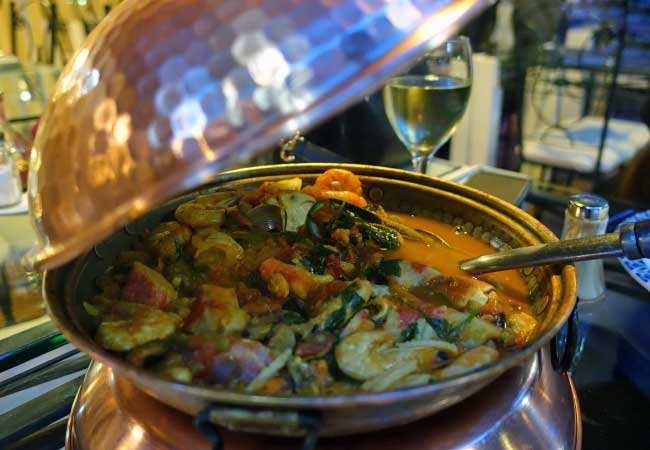
Cataplana is served in a traditional copper dish
Hire a bike and cycle to....
Tavira connects to the Ecovia do Litoral, a dedicated cycling route that spans the entire Algarve coastline. This well-maintained path offers cyclists a fantastic way to explore the surrounding region without needing to navigate busy roads.
Heading west from Tavira, the cycle path follows the coastline for 6km to Santa Luzia, a charming fishing village famous for its octopus restaurants. From Santa Luzia, the route continues another 3km to Pedras d'El Rei, where you can leave your bike and cross the wooden boardwalk to reach Praia do Barril beach with its famous anchor cemetery.

The harbour front in Santa Luzia
Eastward from Tavira, the path runs for 7km through salt pans and marshland to the waterfront town of Cabanas. Continuing east for another 12km brings you to the hidden gem of Cacela Velha, a tiny whitewashed village perched on a clifftop with spectacular views over the Ria Formosa lagoon and barrier islands.
For a longer ride, continue east beyond Cacela Velha for 6km more through pine forests to Monte Gordo's wide beaches before reaching Vila Real de Santo António at the Spanish border. The entire route from Tavira to Vila Real de Santo António covers approximately 25km and can be completed in 2-3 hours at a leisurely pace.
The terrain is predominantly flat with only gentle gradients, making it suitable for cyclists of all fitness levels.

Cacela Velha
Praia do Barril beach
Praia do Barril is one of the eastern Algarve's most distinctive beaches, combining natural beauty with fascinating heritage. Until the 1960s, this location housed a thriving Bluefin Tuna fishing community. Today, the former fishermen's cottages have been thoughtfully converted into beach restaurants, cafés, and small shops that retain much of their original character.
The beach's most striking feature is the Cemitério das Âncoras (Anchor Cemetery), where over 100 rusting anchors stand partially buried in the sand dunes. These anchors once secured the complex network of nets used in the traditional "armação" tuna fishing method. As the tuna industry declined, these massive iron anchors were left behind, creating a memorial to this former industry.
Visitors can reach Praia do Barril from Pedras d'El-Rei, either by walking the 1km wooden boardwalk across the lagoon or taking the small tourist train that runs along a narrow-gauge railway.
For active travellers, an excellent 4-hour hiking route connects Tavira to Barril beach, passing through the octopus fishing village of Santa Luzia and the resort area of Pedras d'El-Rei. The return journey can follow the coastline to Praia de Tavira, where you can catch the ferry back to central Tavira.
Related articles: Praia do Barril and Anchor Cemetery guide
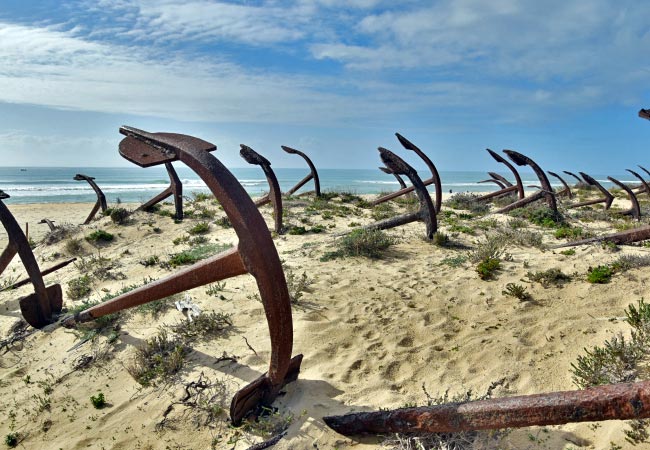
There are over one hundred rusting anchors in the Cemitério das Âncoras
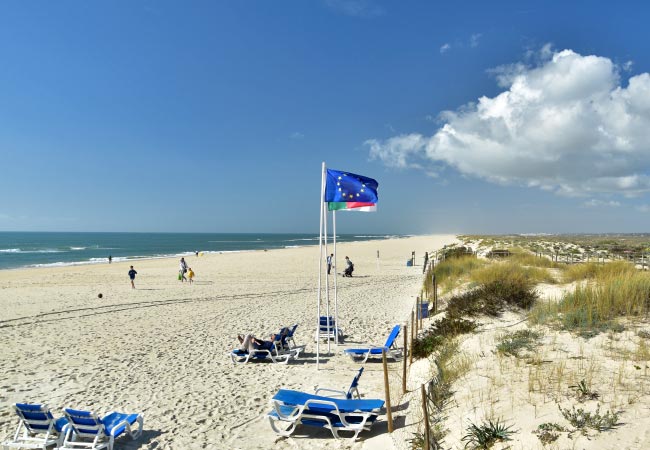
The vast beach at the Praia do Barril
Horse riding at Tavira Equestrian Tourism
Experience the unique thrill of horseback riding along pristine, uncrowded beaches with Tavira Equestrian Tourism. This established riding center offers daily excursions for all ability levels, from complete beginners to experienced riders.
Their beach rides take advantage of the eastern Algarve's extensive coastline, allowing you to trot or canter along the shoreline. The center also offers inland routes through orange groves, pine forests, and the scenic countryside surrounding Tavira. The center provides well-trained horses suited to your riding ability and all necessary equipment. taviraequestriantourism.com/
Day trips from Tavira
Tavira's strategic location in the eastern Algarve makes it an excellent base for exploring the diverse attractions of the surrounding region. The well-connected regional railway and bus network allows for convenient day trips without the need for a rental car.
To the west of Tavira lies Olhão (25 minutes by train), the Algarve's largest fishing port with a distinctive character. The town is famous for its Moorish-influenced cubist architecture in the fishermen's quarter and hosts impressive seafood markets. Visit on Saturday mornings when the waterfront markets are at their liveliest, offering fresh produce and local crafts alongside the day's catch.
Further west is Faro (40 minutes by train), the Algarve's capital with its well-preserved medieval old town encircled by ancient walls. The city's archaeological museum, impressive 13th-century cathedral, and the macabre but fascinating Capela dos Ossos (Chapel of Bones) make for a culturally rich day trip. The nearby Ria Formosa lagoon offers boat trips providing a different perspective of this natural wonder.
Eastward, Monte Gordo (20 minutes by train) attracts visitors with its wide, sandy beach and resort atmosphere. The town offers more developed entertainment options than Tavira, including casino gaming and a livelier nightlife scene.
At the easternmost edge of the Algarve sits Vila Real de Santo António (30 minutes by train), an elegant border town with a distinctive grid layout designed after Lisbon's post-earthquake reconstruction. From here, you can take a quick ferry across the Guadiana River to Ayamonte, Spain, effectively visiting two countries in one day and enjoying Spanish tapas for lunch.
Related articles: Day trips from Tavira
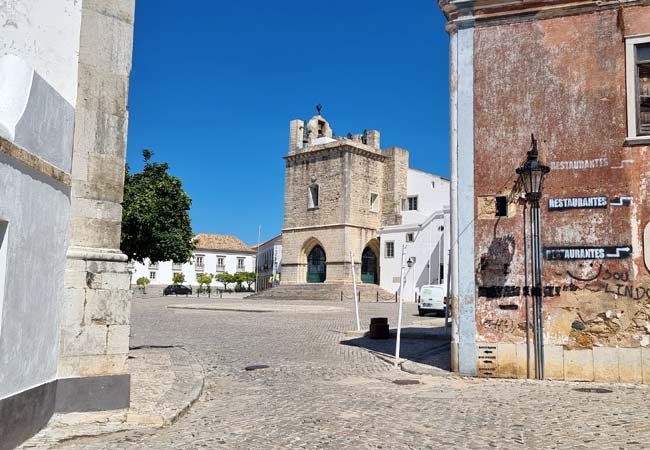
Faro
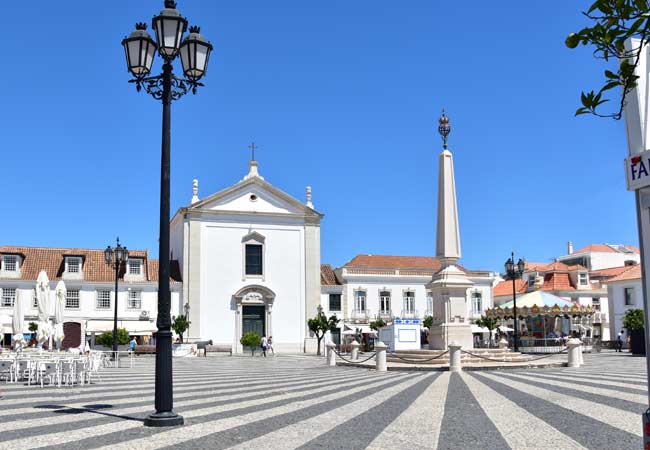
The Praça do Marquês de Pombal in Vila Real de Santo António
Golf in the Eastern Algarve
The eastern Algarve offers exceptional golfing experiences.
Leading the region's offerings is the prestigious Monte Rei Golf & Country Club, consistently ranked among Portugal's top courses. Designed by Jack Nicklaus, this championship course features meticulously landscaped fairways that wind through the serene countryside, with each hole thoughtfully isolated to create a sense of privacy. The course's strategic water hazards, well-placed bunkers, and immaculate conditioning provide a challenging yet rewarding experience for golfers of all abilities.
Benamor Golf Course, located just 4km from Tavira, offers a more accessible option in a beautiful setting. Designed by Sir Henry Cotton, the course takes advantage of natural contours with views across the mountains to the north and the Atlantic Ocean to the south. The course is known for its well-maintained greens and fairways lined with almond, fig, and cork trees native to the region.
For those seeking variety, Castro Marim Golf & Country Club presents three distinct nine-hole loops (The Atlantic, The Guadiana, and The Grouse) that can be combined for different playing experiences. Set within a nature reserve near the Spanish border, the course features challenging elevation changes and strategic water features.
Castro Marim Golf: www.castromarimresort.com
Benamor Golf: www.benamorgolf.com
Monte Rei Golf & Country Club: www.monte-rei.com
Our most popular guides to Tavira and the eastern Algarve
A complete list of all of our Algarve guides
Algarve-South-Portugal.com, with over 200 pages of holiday guides, if it's not here, it's probably not in the Algarve
Wedding dress shopping- Bridesmaids: who to ask? - Finding a wedding dress - Finding a wedding photographer- Creating a seating plan - Choosing wedding favours


























